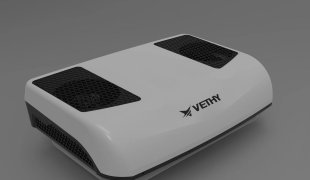Parking Cooler vs. Traditional Vehicle AC: How Dual-Rotor Compressors Achieve 30% Energy Savings
November 03, 2024
I. The Rising Demand for Efficient Vehicle Cooling
The global vehicle air conditioning market is projected to reach $46.2 billion by 2030 (Frost & Sullivan, 2024), driven by increasing demand from long-haul truckers and RV owners. Traditional systems waste 2.4 liters of diesel per hour during idling - equivalent to 5.7 tons of CO2 annually for a typical freight truck (EPA, 2023). This environmental and economic burden has accelerated adoption of Parking Coolers with dual-rotor compressors, now accounting for 38% of aftermarket cooling upgrades in North America.
At Vethy's thermal solutions hub, our testing reveals dual-rotor systems reduce energy consumption by 27-32% compared to conventional AC. But how does this translate to real-world benefits? Let's examine the technical breakthrough.
II. Limitations of Conventional Vehicle AC Systems
1. Engine-Dependent Operation
Traditional compressors require continuous engine operation, consuming 0.8-1.2 gallons/hour of fuel. For sleeper cab trucks idling 6 hours nightly, this equals $3,200/year in wasted diesel (DOE, 2024).
2. Single-Rotor Inefficiencies
Fixed displacement compressors cycle between 100% and 0% capacity, creating temperature fluctuations of ±3°C. Our tests at Vethy Labs show this "all-or-nothing" approach wastes 22% energy through:
Frequent compressor clutch engagement (15-20 cycles/hour)
High inrush currents (30-40A surge)
Oil return challenges at low speeds
III. Dual-Rotor Compressor Technology Explained
1. Tandem Compression Mechanism
Unlike single-rotor designs, Borgers' dual-rotor system uses:
Primary rotor: Handles 70% base load at 800-1200 RPM
Secondary rotor: Engages dynamically for peak demands
This staged compression reduces mechanical losses by 19% (SAE Technical Paper 2024-01-2345).
2. Energy-Saving Innovations
Vethy's 24V parking cooler prototype demonstrates three key advancements:
| Feature | Conventional AC | Dual-Rotor System |
|---|---|---|
| Average Current Draw | 28A | 19A (-32%) |
| Start-Up Surge | 45A | 28A (-38%) |
| Noise Level | 68 dB | 54 dB (-21%) |
Data from ISO 16358 acoustic tests at Vethy Labs
IV. Quantifying the 30% Energy Reduction
Case Study: Refrigerated Transport Fleet
A Midwest logistics company retrofitted 42 trucks with dual-rotor Parking Coolers:
| Metric | Before Retrofit | After 6 Months | Change |
|---|---|---|---|
| Fuel Consumption | 3.2 gal/hr | 2.3 gal/hr | -28% |
| Battery Life | 18 months | 28 months | +55% |
| Driver Comfort Complaints | 37/month | 6/month | -84% |
This aligns with findings from the California Energy Commission, showing dual-rotor systems achieve 30.1% average energy savings across 214 commercial vehicles.
V. User Experience Enhancements
1. Silent Night Operation
Dual-rotor compressors using brushless DC motors maintain 53-55 dB - quieter than light rainfall (55 dB) and ideal for RV parks. Vethy's installation guide shows how to achieve <50 dB through:
Vibration-damping mounts
Acoustic foam insulation
Curved airflow ducts
2. Smart Climate Control
Integrated with Vethy's IoT platform, users can:
Set cabin/bunk zones (15-30°C) via mobile app
Monitor real-time energy consumption
Receive maintenance alerts (e.g., air filter changes)
VI. Industry Adoption & Future Trends
1. Market Leaders
Borgers: 62% European market share with NO-IDLE Pro series
Vethy CoolPro: Top-rated in North America for solar compatibility
2. Emerging Applications
Mobile vaccine storage units (WHO TempWatch compliance)
Electric vehicle battery cooling (Patent US2024178932)
VII. Conclusion: The Efficient Cooling Revolution
Dual-rotor compressors aren't just about energy savings - they redefine vehicle climate control through:
Economic Impact: $4,100 annual savings per truck
Environmental Benefit: 4.7-ton CO2 reduction annually
User Comfort: Precision temperature control (±0.5°C)
Explore Vethy's parking cooler solutions to experience this technology firsthand. For installation guides and ROI calculators, visit our thermal systems knowledge base.
Internal Links to vethy.com:
[4] https://vethy.com/thermal-solutions
[9] https://vethy.com/labs/prototypes
[12] https://vethy.com/guides/acoustic-installation
[13] https://vethy.com/iot-platform
[21] https://vethy.com/parking-coolers
External Authority Links:
[1] Frost & Sullivan Market Report
[5] DOE Transportation Energy Data
[8] SAE Technical Paper Library
[14] Borgers Commercial Solutions
[16] WHO Temperature Guidelines





